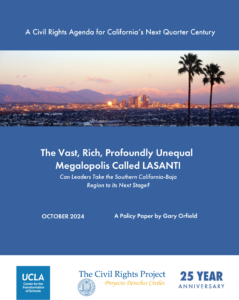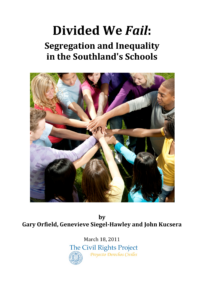Executive Summary
There are 3.6 million public school students in the six counties that make up Southern California (defined here as Ventura, Los Angeles, Orange, San Diego, San Bernardino and Riverside counties). A fifth of all U.S. Latinos, now the nation’s largest minority group, attend school in this region.
Over the last forty years, as a rapid and fateful transformation of the population occurred–and as the deeply imbedded educational inequalities became more and more evident–California has done less and less to address these issues. Civil rights enforcement in education declined dramatically, while, in its place, rose increasingly assertive national and state policies mandating that schools become equal and successful. Those policies were implemented without changing any of the external challenges faced by marginalized families and communities, or the internal realities of disparate teachers and educational opportunities across schools of various racial concentrations.
Southern California schools show profound segregation by race, poverty and language status, all of which are visibly related to disparities in educational opportunity and outcomes. This analysis provides the first comprehensive, region-wide study of enrollment and segregation patterns in the six-county Southern California region. It then addresses the question of why these trends matter: evaluating how segregation is related to graduation rates and college attendance, as well as the distribution of learning opportunities in Southern California. The report is based on data from 2008-09 provided by the U.S. Department of Education and the California State Department of Education.
Rapidly Diversifying Student Population in Southern California
• In fifteen years, the characteristics of the student population in Southern California have shifted dramatically. From 1995 to 2009, each of the four coastal counties in the region – Ventura, Los Angeles, Orange, and San Diego – reported sharp increases in shares of Latino students; while the inland counties of San Bernardino and Riverside saw the Latino proportion climb even more steeply. For example, roughly 39% of San Bernardino’s student population was Latino in 1995, compared to 56% in 2009. Shares of white and black students declined across Southern California during the same period. Enrollment patterns for Asian students suggest their numbers are growing substantially but evenly across the six-county region.
• In 2008, Latino students made up more than one out of two Southern California schoolchildren, but were most heavily concentrated in Los Angeles and the inland counties of Riverside and San Bernardino. One in ten students in the Southern California region in 2008 was Asian, amounting to the second largest concentration of Asian students in the country. A full 17% of students in Orange County schools were Asian, almost twice the share for the overall region. Black students overall represented 8% of the Southern California student population. Schools in Los Angeles County and San Bernardino reported the highest enrollments of black students; Ventura and Orange County reported the fewest. Enrollment numbers for San Bernardino and Riverside suggested a substantial black migration to the far reaches of the Inland Empire.
Deepening patterns of segregation for black and Latino students
Amidst swift demographic shifts in Southern California’s student population, levels of segregation have significantly worsened. As the white population declined, patterns of isolation for Latino students deepened.
• In 1970, the average Latino student attended a metro area school in Los Angeles that was roughly 45% white. By 1980, the proportion of white students in the average Latino students’ school had decreased by more than half, to 21%. Most recently, in 2008, the typical Latino student in Los Angeles Unified School District (LAUSD) went to a school where 6% of the students were white.
During the desegregation battles, black students in the region experienced a brief increase in levels of exposure to white students.
• In 1970s-era Los Angeles, the average black student went to a school that was roughly 14% white, a figure that increased to 16% by 1980—one year prior to the abandonment of the city’s partial desegregation plan. San Diego’s black students went to a school that was, on average, 36% white in 1970 and 42.5% white ten years later. By the start of the 21st century, however, the typical black student in the San Diego Unified School District (SDUSD) attended a school that was roughly 20% white. For the average black student in LAUSD, that figure was only 6%.
Contemporary racial segregation in Southern California
Given the racial complexity of the region’s students, we examined segregation in several different ways. Yet all measures pointed to a basic fact: Southern California’s students were extremely stratified in schools across the six counties.
• In 2008, more than two out of five Latino students and nearly one-third of all black students in the region enrolled in intensely segregated learning environments–schools where 90-100% of students were from underrepresented minority backgrounds. Just 5% of Southern California’s Asian students attended intensely segregated minority schools, and 2% of the region’s white students did the same.
• White students made up 25% of the region’s public school enrollment. Yet the average white student in Southern California attended a school that was nearly 50% white, a figure that highlights persistent patterns of disproportionate white isolation across the region.
• Together, white and Asian students made up 36% of the region-wide population. On average, however, black and Latino students in Southern California attended a school where less than a quarter of students are white and Asian.
Double and triple segregation by race, poverty and language
Overlap between concentrations of race and poverty in schools
• More than half of Southern California’s students were eligible for free and reduced price lunch (FRL) in 2008, a rough proxy for relative student poverty in the region. That figure represents a notable increase in the number of students from all racial groups living in poverty in just one year (from 53% to 56%, with a pronounced increase occurring in the Inland Empire), and was emblematic of myriad challenges facing under-funded school systems in the six-county area.
• Keeping in mind that 56% of Southern Californian schoolchildren qualified for free or reduced priced lunches, the average white student in the region attended a school where FRL students made up just a third of the population. Contrast that figure to the school of the average black or Latino student, where more than half — 63% and 69%, respectively — were FRL eligible students. These figures highlight a racial chasm in students’ exposure to poverty across the region.
• Poor children were substantially more likely than non-poor children to attend schools with higher concentrations of black and Latino students. One of the starkest examples of that relationship existed in Orange County. In the OC, FRL eligible students attended schools where, on average, nearly two-thirds of the students were Latino. Students ineligible for FRL in Orange County, on the other hand, went to schools where under one-third of the students were Latino.
• Poverty concentration in Southern California’s middle and high schools is even greater than racial and ethnic isolation. Virtually all secondary students were considered low-income once the student body of a middle or high school became more than 80% underrepresented minority.
• Schools also tended to reflect the racial and socioeconomic makeup of their surrounding neighborhoods. On average, over a quarter of households (26.2%) surrounding high schools enrolling majority White/Asian students (those enrolling 0-49% underrepresented minority students) earned greater than twice the state median of $62,500 annually, in comparison to 15.6% and 7.8% of households surrounding segregated (those enrolling 50-89% underrepresented minority students) and intensely segregated schools, respectively.
Overlap between racial and linguistic concentrations in schools
• Southern California’s Latino students were most likely to attend schools with high concentrations of English Language Learners (ELLs). The average Latino student in the region attended a school where ELL students comprised nearly 30% of the total enrollment. This figure, in tandem with patterns suggesting Latinos are most likely to experience schools with high and overlapping concentrations of poverty and students of color, suggests that Latino students in the region experience triple segregation (by race, poverty, and language). Linguistically isolated educational settings face many of the challenges found in high poverty, high minority schools.
• In Southern California, ELL students were much more likely than non-ELL students to be enrolled in schools with high concentrations of Latino students, according to a 2005-06 data sample from the U.S. Department of Education. The average student classified as an English Language Learner attended a school that is 73% Latino. In comparison, non-ELL students attended districts where Latino students made up 38% of the population. Non-ELL students in Southern California also reported significantly higher levels, on average, of exposure to white students.
Racial Opportunity Gaps in Southern California
• Teacher quality is an extremely influential, school-level factor related to students’ academic success. In 2008, students in intensely segregated schools were close to three times as likely to have a teacher lacking full qualifications than students attending majority white and Asian schools.
• A critical step for postsecondary success is access to college preparation resources in high school. In California, this equates to access to A-G courses taught by instructors qualified in the content area. Across Southern California counties, intensely segregated and segregated schools of color experienced a greater shortage of A-G courses and college preparatory teachers than majority white and Asian schools.
• Another critical predictor for postsecondary success—and related economic mobility—is secondary students’ exposure to an advanced mathematics curriculum, especially for students of color. A measure of such a curriculum is access to advanced mathematics (Algebra II and higher) or Advanced Placement (AP) mathematics courses in high school. In 2008-2009, the higher the underrepresented concentration of students in a Southern California high school, the less likely a rigorous mathematical curriculum was offered to its students.
• Overcrowding creates unsafe and ineffective learning environments. Over twice as many intensely segregated secondary schools were identified by the state as critically overcrowded compared to predominately white and Asian schools (those enrolling 0-10% underrepresented minority students).
Racial Outcome Gaps in Southern California
• Across Southern California, less than 50% of Grade 9 students in intensely segregated schools graduated on time. In schools educating a majority of white and Asian youth, 81% graduated on time.
• In terms of college matriculation, 22% of Grade 9 students from intensely segregated schools enrolled in some form of California postsecondary institution in the fall after graduation; in majority white/Asian schools, close to twice that amount (43%) of students enrolled in a two-year or four-year postsecondary institution.
As the number of white students continues to decline and as students from historically excluded groups become the large majority in Southern California, it is time to reopen the policy discussion on the issue of school segregation; not as a panacea, not as something that is feasible everywhere, but as a critical element in developing the region’s human capital and preparing students from all groups for the society in which they must learn to collaborate effectively on the job and in community life. Without appropriate shifts in policies and attitudes, segregation in Southern California will continue to deepen and evolve in increasingly harmful ways–threatening the future viability of the region. Divided, we fail.
This paper is part of the LASANTI Project, which explores many dimensions of social and economic change and inequality across the huge bi-national urbanized complex, stretching from the northern Los Angeles suburbs down through San Diego, to the Tijuana metropolitan area.
See a full description of The Lasanti Project here.
In compliance with the UC Open Access Policy, this report has been made available on eScholarship:





